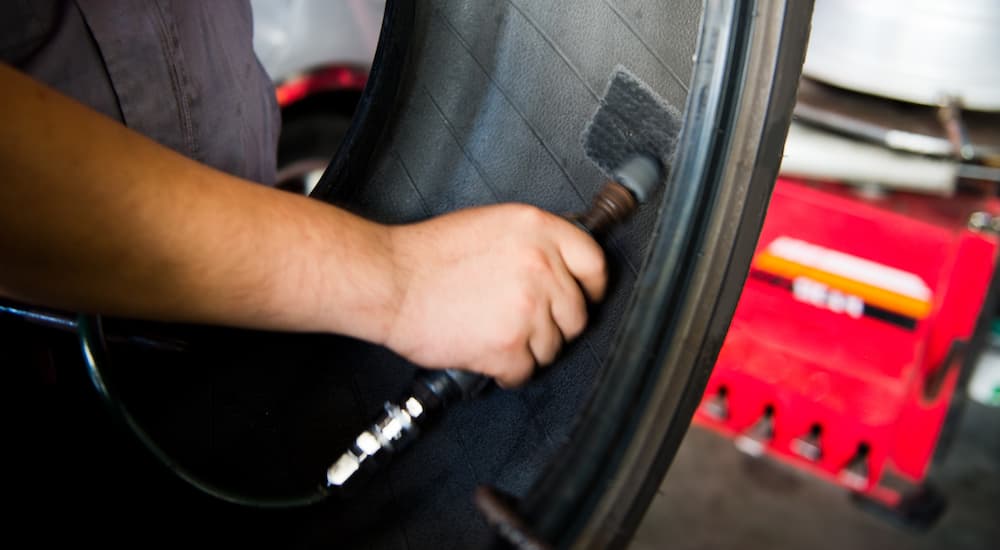Sooner or later, almost every driver is going to have to deal with a punctured tire. No matter how carefully you might drive, road debris, jagged curbs, and other hazards will take their toll on your tires and result in the panic-inducing hiss that’s the bane of all thrifty drivers. There are a few choices when the inevitable happens, from the D.I.Y. approach to a visit to your local mechanic, dealership, or tire repair shop. But what separates a minor puncture from a major blow-out? How difficult is at-home tire repair and when it is time to turn to the professionals?
Tire plugs and patches are two of the most popular choices when it comes to tire repair, though they can differ greatly in terms of difficulty, time, and effectiveness. Full-on replacement is never a driver’s first choice, given the associated costs, but in some cases, it’s a downright necessity. Follow along as we look at the difference between the patch and plug approach, debate between repair or replacement, and look at why sometimes there’s just no beating the professional approach.
Plug vs Patch
When it comes to tire repair, there are four different methods to choose from. For smaller repairs, a simple tire plug kit will usually do the job. Stepping up a level, tire patches can be used for larger repairs and those in more challenging areas, but they require more mechanical know-how, equipment, and time than plugs. Plug-and-patch kits are a third option, and while they’re generally a solid choice for at-home mechanics, they present all the same challenges as a patch kit. Lastly, there’s full-on tire replacement. This is only reserved for tires that don’t qualify for the plug or patch methods and are easily the most expensive out of the choices listed here, especially when you consider that experts generally advise drivers to repair not only the damaged tire but also the tire opposite it in order to ensure even wear, safety, and traction. So how do plugs and patches differ in their approach and difficulty?
Plug
The quickest, easiest option for a small puncture, a plug kit typically costs as little as $6 and doesn’t require a great deal of mechanical knowledge. Best used for punctures caused by nails and other blunt objects, a tire plug is basically just a long piece of pliable rubber that is inserted into the hole and then trimmed away until it’s flush with the tread of the tire. After it’s inserted, the plug begins to expand, creating an air-tight seal that’s surprisingly effective. All that’s left to do is pump the tire back up and use a solution of water and dish soap to see if there’s any air still escaping from the tire.
A tire plug’s main advantage comes down to ease of installation. Unlike tire patch kits requiring a tire to be removed from the wheel, plugs can be installed while the tire is still attached. This means no messing around with jacks, jack stands, grinders, and lug wrenches, resulting in a process that can be completed in minutes. Tire plug installation also doesn’t require any specialized tools aside from a corkscrew-type device which is almost always included in a tire plug kit.
Many swear by tire plugs and say they can outlast time, but there are conflicting opinions on this tire repair process. If a tire plug has been properly installed, it can last as long as seven to ten years, which is to say, longer than the recommended life of your tires themselves.

Patch
For those D.I.Y.-ers who are up for a bit more of a challenge, there’s the tire patch. This is generally considered to be a higher-quality repair than the plug method, but it also requires a few specialized tools, know-how, and experience to pull off. It’s cheap, but unlike a plug that is installed through the tire’s exterior, a radial tire patch is a flat piece of rubber that’s inserted inside the tire itself. When air is pumped back into the tire, the patch expands, sealing off the puncture and melding to the rubber to form a tight bond. While this approach can be useful for larger holes and those located in weaker areas of the tire, it’s a lot more labor-intensive than the plug approach as it involves no less than ten steps.
A tire patch requires drivers to:
- remove the tire and valve stem core
- separate the tire from the rim
- smooth out the puncture hole using a grinding tool
- clean the area around the hole
- apply vulcanizing rubber cement to the area
- apply the tire patch
- seal the patch
- reinstall and repressurize the tire
It’s a far cry from the relatively simple tire plug, which can be applied with little more than a corkscrew, and could be an intimidating task for many drivers. The grinding step, in particular, can be difficult to master as it’s all too easy to take off too much material, weakening the tire, or leave too much and risk a faulty seal. While a professional patch job is more expensive than the at-home route, it’s also likely to offer better results. Like a tire plug, patches can last up to seven to ten years.
A plug-and-patch kit combines both these methods into one and offers the best possible outcome of the three. That said, they do tend to be slightly more expensive than plug or patch kits on their own and require all the time, patience, and tools as the patch method.
Repair vs Replace
Tire punctures come in all different shapes and sizes, so before deciding how to proceed, it’s important to figure out the severity of the damage. Today’s tires are amazingly resilient, but sometimes no amount of repair is going to bring a busted tire back from the dead. There are four major factors to consider when assessing a punctured tire: location, size, frequency, and wear. Let’s take a closer look at each and help you decide whether you’re looking at a simple D.I.Y. plug job, professional patching, or investing in a whole new tire altogether.
Location
The location of the puncture can make all the difference when it comes to tire repair. The actual repairable area of a tire is smaller than most drivers might think, only really extending across the tire’s tread area. Any punctures in the tire’s sidewall or shoulder cannot be safely fixed using a patch or plug approach and will often necessitate the purchase of a new tire. For those not up on their tire anatomy, the sidewall is the smooth vertical area on the side of a tire that extends from the bead (inner edge where the tire meets the wheel) to the edge of the tread on top of the tire. The shoulder is a little harder to define but typically describes the rounded outer edge of the tread. Tire repair is difficult in these two areas due to the lack of steel belts that extend from the edge of the tread across the top, flat surface of the tire, providing it with stability and strength.
Size
The size of the puncture is obviously a big factor when it comes to repair. Generally speaking, anything larger than 1/4 inch (6mm) in diameter shouldn’t be patched as the risk for future failure is simply too high. While there are some exceptions when it comes to larger tires, the 1/4-inch threshold is generally a good rule of thumb for vehicles with tires through load range E, which encompasses most passenger vehicles and light trucks.
Frequency
Multiple punctures can present some real problems for drivers, especially if they are grouped close together. Tires can really only be repaired when punctures are more than 16 inches apart. Any closer and you start to risk the structural integrity of your tire, creating a drastically weaker area that’ll be more prone to blow-outs and other catastrophic damage down the line. This 16-inch rule applies not only to punctures sustained at the same time but all the damage a tire has experienced over the course of its service life. It’s also important that a new repair does not encroach on an old repair, as all the same risks will apply.

Wear
You should also consider the age and mileage of your tire before making a repair. The more miles on a tire, the thinner the material is, and past a certain point, tires can easily become too thin to warrant repair. Luckily most tires have a tread wear indicator built into the tire itself, usually in the form of so-called “wear bars” that are found in the deepest grooves of the tire. When these wear bars become flush with the tread, it’s a good indication that you should start shopping around for a new pair instead of attempting a repair. If you don’t want to use the tread wear indicator as a guide, just make sure that the groove is at least 2/32-inch deep on all parts of the tire.
The Professional Advantage
When it comes to smaller jobs, tire repair isn’t the most difficult D.I.Y. task out there, with a tire plug and patch kits typically available for as little as $6 to $10. That said, it’s important to consider that you’ll be putting your D.I.Y. skills to the test every time you step behind the wheel. If you’re confident enough with your assessment and repair proficiency to cruise the highway at 80 mph on a tire that you repaired, more power to you, but there are more than a few reasons to call in the pros.
Expertise
Any auto mechanic, dealership, or tire retailer has seen countless punctured tires roll through the shop and can be a valuable asset when it comes to figuring out how to proceed with a repair. Most importantly, an experienced mechanic or tire specialist is going to be able to help you decide between a plug for smaller punctures, a patch, or a patch-and-plug approach for tires with more severe damage or, worst case scenario, a new tire altogether.
Equipment
If you don’t have the right equipment lying around your garage or workbench, D.I.Y. tire repair can often be more trouble than it’s worth. Given the relatively low cost of professional repair, it doesn’t always make much sense to invest in not only a tire repair kit but also the jack, jack stands, lug wrench, and air compressor you’ll need to complete the job from the comfort of your own home. It’s also important to factor in how much your own time is worth to you. Tire repair isn’t a very time-consuming process, but there’s no beating the efficiency and time-savings that a professional mechanic can offer.
Safety
Failure to properly repair a tire could potentially cause your next drive to go bad in a hurry. Without extensive experience, it can be difficult to assess how thorough your D.I.Y. repair was, which could well result in a dangerous situation for drivers and passengers alike. A repaired tire might seem perfectly functional at lower speeds only to fail at the worst possible moment, like when you’re trying to overtake another vehicle on the highway. While not as dire as a blow-out, a poor repair job could also cause further damage to the tire itself and increase the likelihood of future incidents. Professional tire repair shops and mechanics not only have the experience to do the job right, they also often offer some sort of guarantee so that if something should fail, it won’t all be on you.
Affordability
As we mentioned earlier, professional tire repairs can be surprisingly affordable. This is especially true when you consider the alternatives, which could include buying a whole new pair of tires or an expensive accident and the resulting hike in your insurance rates. Given these choices, professional tire repair is a pretty easy choice and typically only costs between $10 and $30 per tire. The cost of the repair will likely depend on the severity and size of the puncture, though in some cases it can even be free with many mechanics and tire retailers offering a warranty on any tires purchased. A tire patch or plug kit might seem like a bargain at $6 to $10, but when you consider how much you could end up paying if the repair fails, it’s a no-brainer.

When in Doubt, Take It to the Professionals
Tire repair might seem intimidating, but with a little practice, it’s easy to develop the skills necessary to be able to tell a simple D.I.Y. repair from a job that might require some professional input. A tire plug can be a cheap, easy fix in many cases, but it’s important to know when the job calls for something a little more heavy-duty. It can be well worth a driver’s time to develop a relationship with a particular tire repair shop. This will not only allow the shop to get to know you, your vehicle, and your particular tire needs but could also really pay off when it comes time for your next tire repair. Some shops might offer drastically cheaper or even free tire repair for longstanding customers knowing that when your current set finally outlives its usefulness, you’ll be buying your next pair from your trusted tire source.

